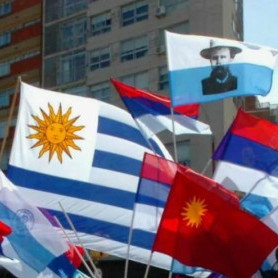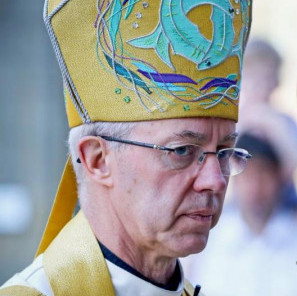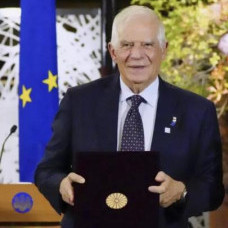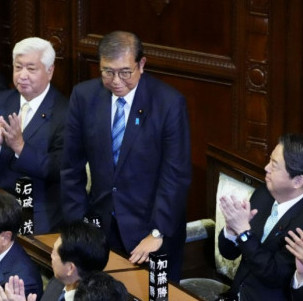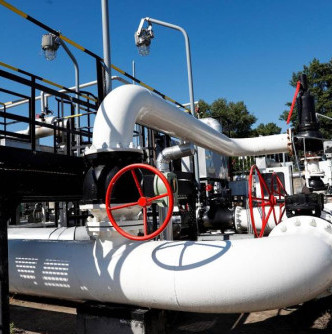Remorse-Free Land
Common sense suggests that any monument unless it commemorates Evil, is a symbol of time – be it our time or our ancestors’ era. The latter of course can only be judged by God and History. The bronze Soviet soldier had come to Tallinn to liberate the small country from the Nazi invasion. He had hardly reflected on the political significance of his arrival. He only followed his orders and the Motherland’s call to fight the Nazi invaders. He wears three medals, which means he was not a communist commissar; and he wasn’t a big commander either. He must have been a recent conscript then, because very few participants in the pre-war “occupation” of the Baltics had lived till 1944, especially privates. His gun behind his back, he now stands in silence guarding the tomb of 13 of his 70 brothers-in-arms, who had given their lives for Estonia.
Who is this boy? Is he an Estonian bowing to the memory of his Russian fellows? Or a Russian paying last tribute to his brother-soldiers, Russians and Estonians alike? Is it that important after all? What’s important is that he commemorates the Great Patriotic War, which was in fact a large part of WW2. The latter, as is generally accepted, had confirmed the victory of Good over Evil. Any other interpretation is seen as justifying Nazism and is subject to legal action…
The Tallinn soldier is not justifying anyone or anything; neither is he threatening or urging. Soldiers do not do anything of the kind. What could have happened to him after 1944? He could have been killed later – the war was still going on. Or, he could have escorted trains with “collaborators” heading for exile. True, those people were not all evil; however, the U.S. – a model democratic nation – did the same thing to the Japanese who had lived there before Pearl Harbor. They were not even “collaborators,” but some of them were finally rehabilitated only in mid-1990s. A war is not over in one day. But that soldier, if he survived, could have stayed and participated in the restoration of Tallinn. Why, he could even be the grandfather of someone in the current Estonian government. Anyway, what happened before and after is not so important as the moment of time depicted by the sculptor: the year 1944, the liberation of Tallinn.
But Estonia’s lawmakers ruled differently. They don’t care if he liberated anyone or not. It is not said aloud, of course, but it is implied that life was better under Hitler’s occupation. The Bronze Soldier is metaphorically seen as the last servicemen who lingered in Estonia after the “occupation” [Russian] army pulled out. They might as well deny him citizenship, in line with their latest law trends – he’s uncomplaining and even speechless. But of course, it would be best to remove him, as Estonia is declared a land free from any visual memories of its large neighbor. The Bronze Soldier can now be removed in accordance with the new laws; the fallen heroes’ remains can be swept away, too, for company. But what about the 35% of Estonia’s own citizens who disapprove of dismantling the monument? According to statistics, almost 80% of them (at least 73%) are Russian speakers. Doesn’t the new law aimed at annoying Moscow, insult them instead? And if they feel insulted, how much would they care about interethnic stability?
It is worth recalling international experience here. Memorials to victorious WW2 soldiers are usually protected by governments of all countries liberated by the Anti-Hitler Coalition. Where there are no relevant laws, such memorials are protected by appropriate public associations, religious groups or local lore and history societies. The governments and war veterans’ organizations of the victorious countries contribute to that protection as well. How well the memorials are cared for shows the country’s attitude toward the very fact of the Nazis’ defeat and toward its own role in that defeat and awareness of its consequences. Indicatively, descendants of German antifascists are among those laying flowers to similar “Soldiers” fixed up in Germany. What the statue commemorates is more important to them than what country’s uniform it wears.
The same holds true for war burial-grounds. Opening of tombs can only be legally authorized if there is a need to check them for explosives or to conduct investigations related to those buried. Even so, it must be agreed with the government of the country whose citizens are buried there.
Up until mid-1990s, no political force-majeure violated the sanctity of attitude toward the defeaters of Nazism. Even China’s violent Red Guards who in the early 1960s smashed everything related to Russians and Soviets, stopped short of vandalizing our memorials, surrounded by impressive fences. Russian tombs were well cared for and protected behind those fences as the “Chinese people’s revolutionary history” memorials. Our East-European neighbors, Hungarians for example, surrounded the Liberator Warriors by modern parking-lots, open-air markets and Loona Parks 30 years from their liberation. But they, too, stopped short of removing the monuments. It looks like the farther from the Baltic winds, the more common sense people show…
Proposals Open
The unofficial top three nations pursuing predominantly anti-Russian policies are Estonia, Poland and Latvia, with Estonia topping the list of course. Therefore, by adopting the “Bronze Soldier Acts,” they have simply confirmed their political course, which is no news to anyone. On the other hand, Russia has to make some political moves this time, not just express its disapproval in a statement. One who doesn’t respect oneself isn’t respected by others either.
First of all, one should distinguish between righteous emotions and legal practices. There are legal acts which establish the superiority of international law over national ones. If united Europe aspires to have an international standard-setting status, it is now given a perfect chance to prove its compliance with the “integration via tolerance” principle. Whereas integration with one partner via isolation from another is essentially DISintegration. Even Tallinn might show enough common sense to agree with this, let alone Brussels and Strasbourg.
Therefore, it would be better if the Bronze Soldier “soldiered on” for a while, rather than was replaced by some new “memorial” of the insult Estonia has thrown at Russia. That “memorial” would be harder to “dismantle.” An offer to redeem our monuments or pay for the land used won’t do Russia any good either. A precedent created once, we’ll soon face a number of price-lists from other countries hosting Soviet war memorials which can be dismantled. On the other hand, the Tallinn Bronze Soldier should not get mingled in common bargaining involving barrels, pipelines, canned sprats and customs. He shouldn’t get near this earthly fuss. But even in the diplomatic “fuss,” our proposal should be outlined firm and clear: Russia expects “Old Toomas” to confirm abidance by international practice by a certain deadline. It does sound like an ultimatum similar to the one Marshal Zhukov once issued to the top Wehrmacht Command, but what’s wrong with that? While waiting for response, it would be wise to monitor the Bronze Soldier situation, emotionlessly reminding every once in a while how much time is left. Once some guarantees are provided, we’ll draw the line and turn to other important issues at hand.
Even if Tallinn views it as a new “expansionist challenge,” Moscow shouldn’t argue. It would be wiser to ask international legal institutions about sanctions they usually slap on those who dare “revise” the WW2 outcomes. It would be quite right to use the experience of the Anti-Hitler Coalition nations and that of countries having monuments to Coalition soldiers. The issue is too sensitive to afford direct comparisons between PQ-17 convoy marines and Russian tankers burned in their T-34s. The U.S. Department of Veterans Affairs is said to be one of the most “nonpolitical” and “difficult” ministries in that country’s government. Israel’s WW2 veterans are also extremely touchy and have sufficient international influence. Even China and Korea are giving more attention than ever to their own WW2 heroes these days.
If this policy yields no result, we’ll have to acknowledge the need to rebury the Soviet soldiers who liberated Estonia – but all of them and after a detailed and open study of archives. They will have to be reburied because Estonia fails to show due respect for the memory of the victims of Nazism. A project to design a new monument to Soviet liberators of Estonia to be fixed up on Narva’s Russian bank or, say, on Moscow’s Poklonnaya Hill – some place where wreath are laid under international protocol, would be a good emotional and political move. The reburial procedure proper will be emotional and ceremonial alike: exhumation, loading on the vehicles, commemoration guards on every site of important WW2 battles along the way, a solemn funeral ceremony on the Russian bank. Even Al Jazeera might make a story out of it, let alone CNN and others… Especially if democratic Estonia, unlike the Saddam Iraq, denies them entry. I won’t elaborate here in a hope we won’t come to this. Just imagine the strength and amount of new political emotions “Old Toomas” will have…
Still, it is much easier to break up than to reconcile. Doesn’t this common wisdom best complement Europe’s key integration principle which is being checked for common sense today?
